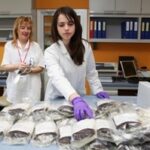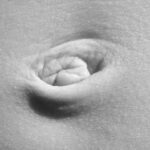Your baby is provided with an abundance of natural protection to help keep it safe in the womb while still vulnerable and developing. Let’s take a look at some of this anatomy.
1. Umbilical Cord: connects the baby to the placenta allowing food and oxygen to be supplied to the baby, and waste materials to be taken to the mother so she can eliminate them. This occurs through the two umbilical arteries and one umbilical vein. It also acts with the placenta as part of the endocrine system producing hormones to regulate pregnancy.
2. Placenta: both mother’s and baby’s blood circulate through the placenta to allow for the exchange of nutrients, waster materials and other chemicals, however the blood does not usually mix. It is through the placenta that the baby receives all of it’s food and oxygen until it’s ready to begin life on it’s own.
3. Uterus: Also called womb. It is a very strong muscle that surrounds the baby for protection during it’s growth, and later contracts to push the baby out through the birth canal. It starts out very small and hollow but stretches to allow room for the growing baby.
4. Amniotic sac or bag of waters: The bag of waters (amnion) is a balloon like structure that keeps the amniotic fluid in, and keeps the germs and bacteria out.
5. Abdominal muscles: Provide extra protection, support and insulation.
6. Amniotic fluid: The amniotic fluid itself provides a watery environment for the baby that helps to regulate temperature and equalize pressure from outside the womb.
7. Pubic Bone: The symphasis pubis is the front portion of the pelvis. Provides an anchor in the front for the muscles of the pelvic floor and also provides bony protection for the baby.
8. Bladder: As the baby grows extra pressure may be put on the bladder causing the mother to feel the urge to urinate more frequently. This also happens because of the increase in fluid volume during pregnancy, as well as the need for the mother to eliminate wastes made by the baby.
9. Cervix: lower entrance to the uterus, or neck of the womb. During most of the pregnancy it is closed tightly and sealed with a mucous plug to prevent anything from entering the uterus.
10. Mucous plug: Seals the entrance of the womb to prevent infection, etc. The loss of the mucous plug is often one of the signs of active labor.
11. Vagina or birth canal: The canal between the uterus and the external genitalia. It receives the penis during intercourse, and the baby is delivered through it during birth. The muscles of the vagina are very flexible to allow passage of the baby.
12. Perineum: The skin and tissues between the vagina and the rectum. When left intact during birth, the perineum will help clear the mucous from the baby’s airway in what is sometimes called the “Fetal Heimlich Maneuver”.
13. Rectum: The outlet of the intestines.
14. Spinal Column: Provides the bony support behind the baby and also provides the central structure for the body. Created to be flexible it accommodates an incredible weight gain and difference in center of gravity as you continue in your pregnancy.
15. Coccyx bone: Also called “tail bone” it is composed for four or five fused vertebrae and connected to your sacrum by a fibrocartilaginous joint. This allows the coccyx to move slightly back and out of the way, as the baby moved through the birth canal, increasing the size of the pelvic outlet. This is only possible if the mother delivers in a position that doesn’t put her weight or pressure on her tail bone and sacrum.
See additional childbirth education articles and other stories by Angela England
Reference:
- Angela England, is a certified childbirth educator and has other childbirth class handouts and articles available, plus more on the way. Subscribe to her content for future article notifications. >>Human Pregnancy Model – A true to life medical model that chidbirth educators and doctors use.







